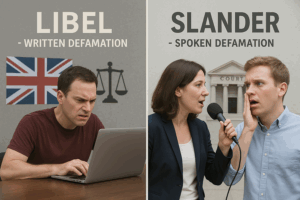Cease and desist letters: Do they work in defamation cases?

A cease and desist letter is a formal notice demanding that a person stop a specific action and refrain from continuing it. Under UK law, such letters serve as an important preventive tool, enabling disputes to be resolved before taking legal action. They are commonly used for intellectual property infringement, contract breaches, harassment, or defamation. In defamation cases, consulting a solicitor specialising in defamation law is essential to ensure the letter is precise and legally compliant.

Key Takeaway: When can a cease and desist letter protect against defamation in the UK?
Read on to discover how these letters work in practice.
What is a cease and desist letter?
A cease and desist letter is a formal letter sent to an individual or organisation demanding immediate cessation of specific harmful actions. Whilst it lacks immediate legal force, it serves as a serious warning that continued behaviour may result in legal consequences. Usually drafted by a solicitor, the letter attempts to resolve disputes before legal proceedings commence.
The primary objectives of a cease and desist letter are to halt harmful actions quickly, prevent dispute escalation, and establish foundations for potential legal should the behaviour persist.
Common uses for cease and desist letters
Depending on the type of issue, a cease and desist letter can play a key role in protecting rights and preventing the escalation of conflicts.
Intellectual property protection
Cease and desist letters frequently address intellectual property violations, including plagiarism, trademark infringement, or counterfeit goods. Companies may send such letters to prevent unauthorised use of protected content or registered trademarks.
Commercial disputes
In business contexts, cease and desist letters address contract breaches, unfulfilled obligations, or unfair competition. They serve as formal warnings before escalating to legal action.
Debt recovery and financial disputes
Cease and desist letters are frequently employed in debt collection scenarios where creditors seek to halt debtor actions such as disposing of assets, continuing business operations that may prejudice recovery, or engaging in conduct that diminishes their ability to satisfy outstanding obligations. Such letters provide formal notice before pursuing statutory demands or winding-up proceedings.
Cease and desist letters in defamation cases
Defamation represents a critical area where cease and desist letters prove invaluable. Under the Defamation Act 2013, claimants must demonstrate serious harm to reputation, making swift action through cease and desist letters essential for preventing further damage.
Cease and desist letters in defamation cases serve multiple purposes:
- Providing formal notice,
- Preserving evidence,
- Demonstrating mitigation attempts,
- Establishing grounds for legal action.
Practical examples:
- Social media case: A business executive discovers false embezzlement allegations on LinkedIn. The cease and desist letter identifies the defamatory post, demonstrates factual incorrectness, quantifies career damage, and demands immediate removal plus apology within 14 days.
- Review platform case: A restaurant receives deliberately false food poisoning reviews from competitors. The letter addresses both reviewer and platform, providing evidence of false claims, demonstrating business harm through reduced bookings, and demanding content removal whilst citing Defamation Act 2013 provisions.
- Blog post case: A professional firm discovers false regulatory breach allegations. The cease and desist letter documents each defamatory statement, provides refuting evidence, quantifies reputational harm, and demands comprehensive retraction with equal prominence.
Effective defamation letters must precisely identify defamatory statements, explain why content constitutes defamation, quantify harm, and specify required remedial actions.
Drafting a cease and desist letter for defamation
The letter must be clear, precise, and professionally written. A solicitor specialising in defamation should draft or review the letter to ensure legal compliance and maximise effectiveness.
Essential components of a defamation letter include:
- Identification of defamatory content: Precisely specify the content, publication date, platform used, and identifying information for the defamatory statement.
- Clear demands: State exactly what the recipient must do. This could be either immediate content removal, public apology, or both.
- Legal consequences warning: Outline potential legal action, including injunction applications, damages claims, or court proceedings if demands are ignored.
Benefits for victims
Cease and desist letters offer:
- Swift reputation protection by stopping defamation before further harm occurs
- Evidence of reasonable conduct if court proceedings become necessary
A well-drafted cease and desist letter often resolves conflict quickly, avoid lengthy and costly procedures whilst protecting the victim’s reputation and serving as solid legal documentation.
Legal limits and precautions
A cease and desist letter is a useful tool to request the stopping of harmful or illegal behaviour, but it has certain limitations that should be understood:
- Cease and desist letters lack immediate legal enforcement power and cannot compel instant compliance.
- Recipients may ignore the letter entirely, requiring subsequent court proceedings.
- Poorly drafted or overly aggressive letters risk escalating conflicts, damaging credibility, and potentially exposing senders to harassment claims.
Essential precautions:
- Timing and service: Send letters immediately upon discovering harmful behaviour using traceable delivery methods with proof of receipt.
- Evidence preservation: Before sending, preserve all evidence through screenshots, witness statements, or legal notices to platforms.
- Proportionate response: Ensure demands are proportionate to harm caused. Excessive demands may indicate bad faith in subsequent legal proceedings.
- Follow-up strategy: Establish clear compliance deadlines and prepare contingency plans. If unsuccessful, be ready to initiate legal action, seek injunction relief, or explore alternative dispute resolution. Consider whether a second, more formal letter from a solicitor might prove more effective before commencing court proceedings.
Do I need a solicitor to draft a cease and desist letter?
Engaging a solicitor is not mandatory when sending or receiving a cease and desist letter, but it is highly recommended to ensure your rights are protected and your actions remain legally compliant.
Using a solicitor when drafting a letter can help to:
- Ensure legal compliance: Guarantee the letter adheres to current law and that legal warnings are correctly formulated.
- Draft a clear and precise messaging: Specify exactly what behaviour must cease, and outlining supporting evidence and facts, whilst avoiding ambiguity.
- Maintain professional and neutral tone: Prevent claims of excessive intimidation or defamation within the letter itself.
- Maximise prospects of amicable resolution: Well-crafted letters are significantly more likely to receive favourable responses without court proceedings.
As a recipient, essential actions include:
- Carefully reviewing the letter to fully understanding allegations and specific requests made.
- Verifying claim legitimacy and assessing whether allegations are factually and legallyvalid.
- Evaluating your response options, including considering formal replies, contesting content removal, issuing apologies, or challenging allegations through legal channels.
- Preserving all evidence and communications. Documentation may prove crucial if disputes escalate to formal legal action.
FAQs
Is a cease and desist letter legally binding? No, a cease and desist letter is not legally binding itself, but serves as official notice supporting potential legal action.
Can drafting the letter improperly weaken my case? Yes, poorly drafted letters can undermine your position, create confusion, or be used against you in court proceedings.
What if the other party ignores it, what comes next? If the recipient ignores the letter, you may proceed with formal legal action, such as filing a lawsuit or requesting an injunction.
How long does the recipient have to respond to a cease and desist letter? There is no legal requirement for response timeframes, but letters typically specify reasonable deadlines (usually 7-14 days). Recipients should respond promptly to demonstrate good faith, as delays may be interpreted negatively in subsequent legal proceedings.
Can I send a cease and desist letter without evidence of harm? While you can send a letter without comprehensive evidence, it significantly weakens your position. Defamation cases require proof of serious harm under the Defamation Act 2013. A solicitor can help assess whether sufficient evidence exists before sending the letter to avoid undermining your credibility.
Cease and desist letters serve as strategic tools for protecting your rights whilst attempting amicable dispute resolution. Success depends on clear, professional drafting, and understanding legal limitations. Whether sending or receiving such letters, solicitor consultation significantly improves outcomes and ensures proper legal compliance.
Make the most of a solicitor’s expertise!
Qredible’s network of specialist solicitors provides expert assistance in drafting effective cease and desist letters that achieve results.
KEY TAKEAWAYS
- Cease and desist letters lack immediate legal enforcement power but serve as crucial official notices and documented evidence for potential court proceedings.
- Effective letters must be professionally structured, factually accurate, and legally compliant whilst avoiding threatening or defamatory language that could undermine credibility.
- Maintaining comprehensive proof of delivery through traceable methods is essential for documenting communications and supporting future legal action.
- Solicitor consultation significantly enhances success prospects, ensuring legal compliance and strategic effectiveness whether drafting or responding to cease and desist correspondence.
Articles Sources
- justice.gov.uk - https://www.justice.gov.uk/courts/procedure-rules/civil
- gov.uk - https://www.gov.uk/guidance/defamation
- legislation.gov.uk - https://www.legislation.gov.uk/ukpga/2013/26/contents/enacted
- lawsociety.org.uk - https://www.lawsociety.org.uk/topics/legal-guides/cease-and-desist-letters
- citizensadvice.org.uk - https://www.citizensadvice.org.uk/law-and-courts/libel-and-slander/
Do you need a solicitor?
Find a solicitor on Qredible in just a few easy steps
















